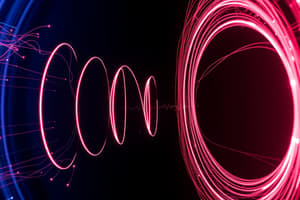Podcast
Questions and Answers
What characterizes permanent magnets compared to temporary magnets?
What characterizes permanent magnets compared to temporary magnets?
- They retain a greater amount of magnetism. (correct)
- They are made from materials of low reluctance.
- They cannot be produced from special alloys.
- They are easier to magnetize.
Which of the following materials are considered low reluctance materials?
Which of the following materials are considered low reluctance materials?
- Copper wire
- Steel alloys
- High-carbon steel
- Soft iron (correct)
What is meant by residual magnetism?
What is meant by residual magnetism?
- The initial magnetism present in a permanent magnet.
- The temporary magnetic field created by electrical current.
- The maximum amount of magnetism a material can hold.
- The magnetism that remains in a temporary magnet after the magnetizing force is removed. (correct)
What demonstrates that magnetic force is not uniform around a magnet?
What demonstrates that magnetic force is not uniform around a magnet?
Which type of magnets can easily lose their magnetic strength?
Which type of magnets can easily lose their magnetic strength?
A heavy flow of electrons is passed through a coil to accomplish what?
A heavy flow of electrons is passed through a coil to accomplish what?
Which statement about magnetic poles is correct?
Which statement about magnetic poles is correct?
How does the Earth function in terms of magnetism?
How does the Earth function in terms of magnetism?
What occurs to the force in an electromagnetic coil when it is stretched to twice its length?
What occurs to the force in an electromagnetic coil when it is stretched to twice its length?
What is the base unit of magnetic field strength?
What is the base unit of magnetic field strength?
How is magnetic flux defined?
How is magnetic flux defined?
What is the unit of magnetic flux density?
What is the unit of magnetic flux density?
If a magnetic field has a strength of 1 Tesla, how many gauss does it represent?
If a magnetic field has a strength of 1 Tesla, how many gauss does it represent?
What happens to the magnetic flux when there is a change in the magnetic circuit?
What happens to the magnetic flux when there is a change in the magnetic circuit?
In terms of magnetic flux density, what does 1 gauss represent?
In terms of magnetic flux density, what does 1 gauss represent?
When winding a coil around an iron core, what is the impact on field intensity?
When winding a coil around an iron core, what is the impact on field intensity?
What is the condition for an atom to be magnetically neutral?
What is the condition for an atom to be magnetically neutral?
Which materials are classified as magnetic materials?
Which materials are classified as magnetic materials?
What is a characteristic of ferromagnetic materials?
What is a characteristic of ferromagnetic materials?
What can be said about natural magnets?
What can be said about natural magnets?
Which of the following statements is true about non-magnetic materials?
Which of the following statements is true about non-magnetic materials?
Which of the following alloys is known for having strong magnetic properties?
Which of the following alloys is known for having strong magnetic properties?
Which ancient culture is known for discovering the principles of magnetism?
Which ancient culture is known for discovering the principles of magnetism?
What is one practical use of lodestones as observed by the Chinese?
What is one practical use of lodestones as observed by the Chinese?
What will happen if a nail made of pure iron is used in the electromagnet setup?
What will happen if a nail made of pure iron is used in the electromagnet setup?
Which component of an electromagnet allows it to return to its unenergized state?
Which component of an electromagnet allows it to return to its unenergized state?
What is the standard unit of magnetomotive force (MMF)?
What is the standard unit of magnetomotive force (MMF)?
What effect does increasing the current flowing through a coil have on the magnetic field?
What effect does increasing the current flowing through a coil have on the magnetic field?
How is the magnetomotive force (MMF) calculated for a coil?
How is the magnetomotive force (MMF) calculated for a coil?
What remains true for a coil with more turns of wire in terms of magnetic field concentration?
What remains true for a coil with more turns of wire in terms of magnetic field concentration?
What is represented by the letter 'H' on the B-H curve?
What is represented by the letter 'H' on the B-H curve?
What will be the magnetomotive force for a coil with 150 turns and a current of 500 mA?
What will be the magnetomotive force for a coil with 150 turns and a current of 500 mA?
What is the term for the amount of magnetization retained by a material when the magnetizing field is removed?
What is the term for the amount of magnetization retained by a material when the magnetizing field is removed?
Which type of materials are referred to as 'magnetically hard'?
Which type of materials are referred to as 'magnetically hard'?
What does coercivity measure in ferromagnetic materials?
What does coercivity measure in ferromagnetic materials?
What is the relationship between residual magnetism and retentivity when a material has been magnetized to saturation?
What is the relationship between residual magnetism and retentivity when a material has been magnetized to saturation?
What phenomenon was discovered in 1820 regarding electric current and magnetic fields?
What phenomenon was discovered in 1820 regarding electric current and magnetic fields?
What is the term for the amount of reverse driving field required to demagnetize a material?
What is the term for the amount of reverse driving field required to demagnetize a material?
What is an example of a material that is considered magnetically soft?
What is an example of a material that is considered magnetically soft?
How are remanence and residual magnetism defined when a magnetic material is not magnetized to saturation?
How are remanence and residual magnetism defined when a magnetic material is not magnetized to saturation?
Which of the following best defines Magnetomotive Force (MMF)?
Which of the following best defines Magnetomotive Force (MMF)?
What does Magnetic Flux Density represent?
What does Magnetic Flux Density represent?
What is the definition of Coercive Force?
What is the definition of Coercive Force?
What occurs at the Saturation Point in magnetism?
What occurs at the Saturation Point in magnetism?
What characterizes Eddy Currents?
What characterizes Eddy Currents?
Which term describes the ability of a material to act as a path for magnetic lines of force?
Which term describes the ability of a material to act as a path for magnetic lines of force?
What does the Hysteresis Loop illustrate?
What does the Hysteresis Loop illustrate?
What does Reluctance indicate in the context of magnetism?
What does Reluctance indicate in the context of magnetism?
Flashcards
Magnetism
Magnetism
The property of a material that allows it to attract iron.
Magnetic Materials
Magnetic Materials
Materials that can be attracted by magnets and can become magnetized.
Non-magnetic Materials
Non-magnetic Materials
Materials that are not attracted by magnets and cannot be magnetized.
Ferromagnetic Materials
Ferromagnetic Materials
Signup and view all the flashcards
Alloy
Alloy
Signup and view all the flashcards
Natural Magnets
Natural Magnets
Signup and view all the flashcards
Magnetite
Magnetite
Signup and view all the flashcards
Lodestones
Lodestones
Signup and view all the flashcards
Artificial Magnets
Artificial Magnets
Signup and view all the flashcards
Permanent Magnets
Permanent Magnets
Signup and view all the flashcards
Temporary Magnets
Temporary Magnets
Signup and view all the flashcards
Residual Magnetism
Residual Magnetism
Signup and view all the flashcards
Retentivity
Retentivity
Signup and view all the flashcards
Magnetic Poles
Magnetic Poles
Signup and view all the flashcards
Magnetic Poles
Magnetic Poles
Signup and view all the flashcards
Earth's Magnetic Poles
Earth's Magnetic Poles
Signup and view all the flashcards
Electromagnet
Electromagnet
Signup and view all the flashcards
Magnetomotive Force (MMF)
Magnetomotive Force (MMF)
Signup and view all the flashcards
MMF - Ampere-Turns (AT)
MMF - Ampere-Turns (AT)
Signup and view all the flashcards
Magnetic Field Strength
Magnetic Field Strength
Signup and view all the flashcards
Basic Relay
Basic Relay
Signup and view all the flashcards
Contact Arm
Contact Arm
Signup and view all the flashcards
Controlled Circuit
Controlled Circuit
Signup and view all the flashcards
Electromagnet Power
Electromagnet Power
Signup and view all the flashcards
Remanence
Remanence
Signup and view all the flashcards
Coercivity
Coercivity
Signup and view all the flashcards
Magnetically Hard Materials
Magnetically Hard Materials
Signup and view all the flashcards
Magnetically Soft Materials
Magnetically Soft Materials
Signup and view all the flashcards
Hysteresis Loop
Hysteresis Loop
Signup and view all the flashcards
Residual Magnetic Flux Density
Residual Magnetic Flux Density
Signup and view all the flashcards
Magnetic Flux
Magnetic Flux
Signup and view all the flashcards
Magnetic Flux Density
Magnetic Flux Density
Signup and view all the flashcards
Field Intensity
Field Intensity
Signup and view all the flashcards
Magnetic Force
Magnetic Force
Signup and view all the flashcards
Permeability
Permeability
Signup and view all the flashcards
Relative Permeability
Relative Permeability
Signup and view all the flashcards
Field Strength
Field Strength
Signup and view all the flashcards
Reluctance
Reluctance
Signup and view all the flashcards
Coercive Force
Coercive Force
Signup and view all the flashcards
Saturation Point
Saturation Point
Signup and view all the flashcards
Eddy Currents
Eddy Currents
Signup and view all the flashcards
Study Notes
Module 3: Electrical Fundamentals, Topic 3.10: Magnetism
- Magnetism is a fundamental concept in understanding electricity.
- Magnetism and electricity are interconnected.
- Electrical and electronic equipment rely on magnetism to function. This includes computers, video equipment, high-fidelity speakers, and electrical motors.
- Two theories explain magnetism: Weber's Theory and Domain Theory.
Weber's Theory of Magnetism
- This theory proposes that all magnetic materials are comprised of tiny molecular magnets.
- In unmagnetized materials, molecular magnets' forces are neutralized by adjacent molecular magnets, thus eliminating any magnetic effect.
- In magnetized materials, molecular magnets align, creating a dominant north pole and a dominant south pole.
- The alignment occurs when an external magnetic field causes the molecular magnets to align in the same direction
Domain Theory of Magnetism
- This is a more contemporary theory based on electron spin.
- All matter is composed of atoms, with atoms containing one or more orbital electrons.
- Electrons orbit the nucleus in various shells, similar to the solar system. Additionally, electrons also rotate on their axis while orbiting the nucleus.
- Unmagnetized atoms have equal numbers of electrons spinning in opposite directions, which cancel out their individual magnetic fields.
- Magnetized atoms have more electrons spinning in one direction than the other, creating a net magnetic field.
- Iron atoms have 26 protons and 26 orbital electrons. 13 electrons spin clockwise with 13 counterclockwise, thus being magnetically neutral. If more than 13 electrons spin in one direction an atom is magnetized.
Magnetic Materials
- Magnetism is a material property allowing attraction of iron pieces.
- Materials attracted by magnets can become magnetised, such as iron, steel, nickel, and cobalt.
- Non-magnetic materials are not attracted by magnets, such as paper, wood, glass, and tin.
- Ferromagnetic materials are easily magnetised, including iron, steel, and cobalt.
- Alloys, like Alnico and Permalloy, can be strongly magnetised, capable of lifting significantly more weight than their own.
Natural Magnets
- Ancient Greeks identified natural magnets, called lodestones.
- Similar to modern magnets, these stones could attract small pieces of iron and oriented North-South.
- Ancient Chinese also recognised the properties of magnetism.
Artificial Magnets
- Artificial magnets are produced from magnetic materials.
- They are frequently made of special iron or steel alloys and are often magnetized electrostatically.
- To magnetize a material, a substantial electron flow is passed through a coil wrapped around the material.
- Artificial magnets are usually classified as permanent or temporary. A permanent magnet retains magnetism and a temporary magnet loses most of its strength when the magnetizing force is removed.
Magnetic Poles
- Magnets have two poles, North and South.
- Like poles repel, unlike poles attract.
- When a magnet is suspended freely, it aligns itself in a north-south direction.
Earth's Magnetic Poles
- The Earth itself acts like a giant bar magnet.
- The Earth's magnetic axis is not perfectly aligned with its rotational axis. It is offset by about 15 degrees.
- The Earth's magnetic pole is sometimes called the magnetic north pole, but actually has the properties of a south magnetic pole, attracting the north pole of a compass needle.
Magnetic Lines of Force
- Magnetic fields, while invisible, are represented by lines, which are referred to as lines of force or magnetic lines of force.
- These lines always form closed loops, beginning at the North pole and ending at the South pole. They are concentrated at the poles and less concentrated at the midpoint.
- The lines close together indicate a strong magnetic field, and the lines further apart indicate a weaker magnetic field.
- When two magnets are brought close together, the lines of force change, becoming more complicated because of attractive or repulsive forces.
Properties of Magnetic Lines of Force
- Magnetic field lines are continuous and form closed loops.
- They never cross one another.
- Closely spaced lines indicate a strong magnetic field; widely spaced, a weak magnetic field.
Eddy Currents
- Eddy currents are microscopic currents flowing within a conductor.
- They are generated when a conductor moves through or is exposed to a changing magnetic field.
- Eddy currents can produce heating effects.
Precautions and Care of Magnets
- Personnel with pacemakers should avoid handling magnets.
- To maximize durability, store magnets in a safe place and avoid knocking or applying high heat.
- Horseshoe magnets should be kept together using a keeper (soft iron bar).
- Bar magnets should be stored in pairs, ensuring opposite poles are together, to prevent loss of magnetic properties.
Terminology Review
- Magnetomotive force (MMF): The flux producing ability of an electric current in a magnetic circuit.
- Field Strength: The amount of MMF available to create a magnetic field for each unit length of a magnetic circuit.
- Magnetic Flux Density (B): The number of magnetic lines of force cutting through a plane of a given area at a right angle.
- Permeability: The ability of a material to act as a path for magnetic lines of force.
- Retentivity: The amount of magnetic flux density a material retains when the magnetizing force is removed after achieving saturation.
- Hysteresis Loop: If an alternating magnetic field is applied to a material, it traces a loop called a hysteresis loop. Magnetic hysteresis is the lag of an effect after the cause.
- Reluctance: Opposition that a material offers to magnetic lines of force.
- Coercive Force: Amount of reverse driving field required to demagnetise a material.
- Saturation Point: The point at which no additional amount of magnetising force will increase flux.
- Eddy Currents: Circular induced currents generated in a conductor (of any type) by a moving magnetic field, or equivalent.
Additional information
- Electromagnets can increase the strength of the magnetic field by increasing the number of coil windings or increasing the current passed through the coil.
- Electromagnets are used extensively in relays, contactors, and solenoids.
Studying That Suits You
Use AI to generate personalized quizzes and flashcards to suit your learning preferences.




